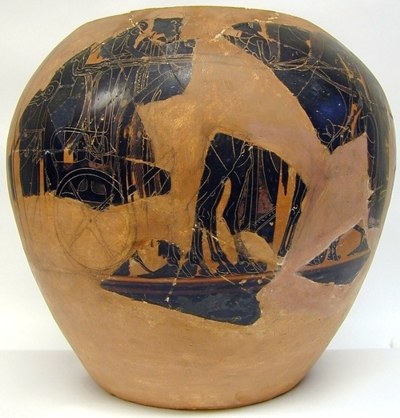Corpus Vasorum Antiquorum Volumes 3 and 4, Göttingen
So far, two volumes of the international Corpus Vasorum Antiquorum, or "CVA" for short, provide information about the original holdings of ancient pottery in the collection of the Archaeological Institute of Georg-August University Göttingen, in addition to old inventories and some older publications. In July 2006, the processing of the black-figure vessels and fragments was completed, and the volume is currently being prepared for printing. It comprises 234 vessels, larger groups of fragments and individual fragments; only a small part of them has been accessible to research so far.
Extensive restoration measures, carried out by the restorer Jorun Ruppel, accompanied the examination (see Fig. 1).

Fig. 1 Condition before the restoration (Photo N. Eschbach)
Numerous partly matching fragments from the front of a belly amphora were connected with an unassociated B-side in a thick plaster mantle - see CVA Göttingen [3] pl. 1, 3 (Inv. K 200) and pl. 3, 3 (Inv. K 201). After separation and cleaning, numerous further fragments could be added (see CVA pl. 2).

Fig. 2: The restored A-side
Inv. K 200, Amphora, fragments
Composed of 76 partly matching fragments (A/B)
From Orvieto, acquired around 1900 from K. Dilthey by R. Mancini
A: Warrior's exit in a four-horse carriage in side view to the right
Mastos Painter, c. 530-520 B.C.
CVA Göttingen (3) Plates 1, 1-3; 2, 1-6; Supplement 1, 1
Photo: Stephan Eckardt
A neck amphora (Inv. K 211) was completely dismantled, freed from brittle additions and plastered-over sections and rebuilt (see CVA Göttingen [3] pl. 10, 2). In the process, long 'missed' inventory labels were found on the backs of some of the sherds - along with other associated fragments - which secure the location and origin of the find: The sherds of the amphora were acquired around 1900 together with a larger contingent from K. Dilthey at R. Mancini in Orvieto (see Fig. 3).

Fig. 3: The sherds after cleaning, before mounting.
Inv. K 211, Neck amphora of the standard form, fragments.
Assembled from 71 partly matching fragments (A/B).
From Orvieto, acquired around 1900 from K. Dilthey at R. Mancini's shop
A: Farewell to a warrior
B: Turning four-horse carriage runs over a falling hoplite
Painter of Cambridge 51, c. 520 B.C.
CVA Göttingen (3) Plates 10, 2; 12, 1-2; 15, 3-4; Supplement 2, 1
Photo: Stephan Eckardt
During the careful restoration, numerous fragments and groups of fragments revealed fractured surfaces with traces of older adhesions (with shellac) and sometimes also register marks on the inside of the sherds, for which there were no corresponding fragments in the holdings of the Vase Collection. In some cases, the associated parts could be discovered in other collections; a fine example is provided by Fig. 4.

Fig. 4: Inv. K 376, Eye cup (type A), fragments (upper half), and: Rome, Museo Nazionale di Villa Giulia, Inv. 79523 (lower half). Composed of five (and seven) fragments.
Göttingen: Rome Art Trade, P. Hartwig (1897).
Rome, Villa Giulia: Castellani Collection
A / B: Between eyes a bearded man leading a ram; c. 520-510 BC
CVA Göttingen (3) pl. 72, 1; supplement 15, 2; 23, 1
Photo: N. Eschbach
Publications on the collection:
M. Bentz - F. Rumscheid, CVA Deutschland Bd. 58, Göttingen Bd. 1, Unteritalische Keramik (1989).
M. Bentz - Chr. Dehl-von Kaenel, CVA Deutschland Bd. 73, Göttingen Bd. 2, Korinthische und Etruskische Keramik (2001).
The fourth volume of the CVA on the Göttingen collection includes Attic red-figure pottery; work began in June 2006. J. Beazley visited the collection in 1936 and paid special attention to the vessels and fragments; 51 objects are recorded in his standard work on red-figure vase painting (ARV2 = Attic Red-Figure Vase-Painters, 2nd edition [1963]), the database of the Beazley Archive in Oxford notes 55 entries.
Two examples from the collection of fragments:

Fig. 1: Bowl, fragment; old inv. H 46;
Euaion Painter (ARV2 793, 69); c. 460-450 BC.

Fig. 2: Colonet crater, fragment; old inv. H 89;
Eucharides Painter (Robertson; ARV2 228, 22); c. 480 BC.
Contact: apl. Prof. Dr. Norbert Eschbach
